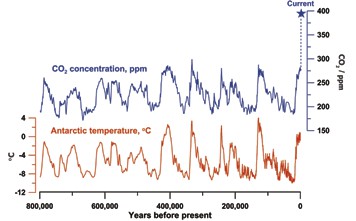
Figure 3. Data from ice cores have
been used to reconstruct Antarctic
temperatures and atmospheric
CO2 concentrations over the past
800,000 years. Temperature is
based on measurements of the
isotopic content of water in the
Dome C ice core. CO2 is measured
in air trapped in ice, and is a
composite of the Dome C and
Vostok ice core. The current CO2
concentration (blue star) is from
atmospheric measurements. The
cyclical pattern of temperature
variations constitutes the ice
age/ interglacial cycles. During
these cycles, changes in CO2
concentrations (in blue) track
closely with changes in temperature
(in red). As the record shows, the
recent increase in atmospheric CO2
concentration is unprecedented
in the past 800,000 years. Source:
Figure by Jeremy Shakun, data from
Lüthi et al., 2008 and Jouzel et al., 2007. | The present level of atmospheric CO2 concentration is almost certainly unprecedented
in the past million years, during which time modern humans evolved and societies
developed. The atmospheric CO2 concentration was however higher in Earth’s more
distant past (many millions of years ago), at which time palaeoclimatic and geological
data indicate that temperatures and sea levels were also higher than they are today. Measurements of air in ice cores show that for the past 800,000 years up until the 20th century, the
atmospheric CO2 concentration stayed within the range 170 to 300 parts per million (ppm), making the recent
rapid rise to nearly 400 ppm over 200 years particularly remarkable [figure 3]. During the glacial cycles of
the past 800,000 years both CO2 and methane have acted as important amplifiers of the climate changes
triggered by variations in Earth’s orbit around the Sun. As Earth warmed from the last ice age, temperature and CO2 started to rise at approximately the same time and continued to rise in tandem from about 18,000 to
11,000 years ago. Changes in ocean temperature, circulation, chemistry and biology caused CO2 to be released
to the atmosphere, which combined with other feedbacks to push Earth into an even warmer state.
For earlier geological times, CO2 concentrations and temperatures have been inferred from less direct
methods. Those suggest that the concentration of CO2 last approached 400 ppm about 3 to 5 million
years ago, a period when global average surface temperature is estimated to have been about 2 to 3.5°C
higher than in the pre-industrial period. At 50 million years ago, CO2 may have reached 1000 ppm, and
global average temperature was probably about 10°C warmer than today. Under those conditions, Earth
had little ice, and sea level was at least 60 metres higher than current levels. |